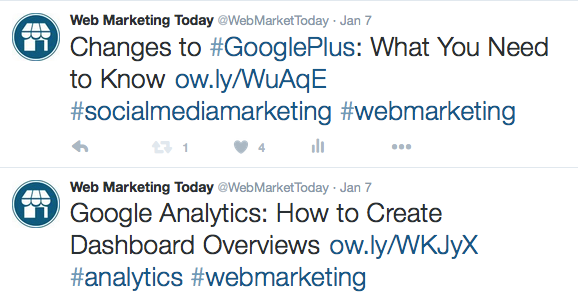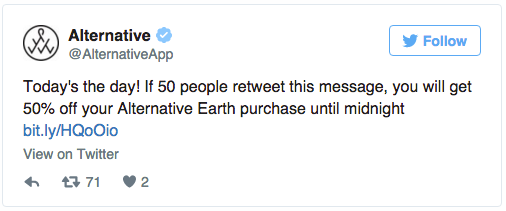Editor’s Note: This article was originally published by Web Marketing Today. Practical Ecommerce acquired Web Marketing Today in 2012. In 2016, we merged the two sites, leaving Practical Ecommerce as the successor.
Although marketing through social media is the norm, Twitter is still an enigma for many. I can’t recount just how many times I have heard business owners and marketers tell me, “I just don’t get Twitter.”
In this article, I help you understand Twitter’s place in the marketing mix, first by explaining its value and then by listing 25 ways to use it.
Twitter’s Value for Marketing
Allow me to illustrate Twitter’s value with the following analogies:
Front door and foyer. If you were to liken social media to a house, Facebook would be the family room, LinkedIn the home office, and a blog the library.
Where does that leave Twitter? As the front door and foyer. It’s a place to meet people, break the ice, and, if you so desire, invite them into your “home” by connecting via other social networks, to deepen the relationship.
News ticker. Twitter is less a social network and more a news and information network. Think of it as the news ticker that you see scrolling continuously across the screen on the 24-hour news channels.
Swiss Army knife. I call Twitter the “Swiss Army knife” of social media. Like the classic penknife, which contains a multifaceted toolset designed to serve a variety of functions, you can use Twitter for multiple purposes, depending on your business goals and needs.
With that understanding, here are 25 ways to make Twitter a social media marketing staple.
1. Choose an Appropriate Username
Your username (@username) is your Twitter handle. If you associate the account with your company, try using your business name or a variation of it. Twitter allows up to 15 characters for usernames.
2. Create a Brand-centric Profile
Your profile consists of a bio, avatar, and cover images. It should tell the story of your business in a single glance, so select visual elements that best represent you.

B2B data provider Zoominfo uses creative imagery and its website color scheme in its Twitter profile.
Write a clear, concise bio — a description of your company in 160 characters or less — that describes your brand, products, and services, and that includes a link to your website or a landing page. Your business’s logo can function as the avatar.
3. Become a Good Listener
Listen first and tweet later is a good motto for using Twitter in a marketing context. Use Twitter advanced search or tools like HootSuite or Sprout Social to look for tweets that include your company name, products, and services. Also, follow your competitors and others in your industry, to see what they are tweeting.
4. Interact and Respond
Reply to tweets about your business, whether they are positive or negative, and do so quickly (within 24 hours). You can like and retweet positive messages, thank those who praise you, and address critical tweets in a helpful, respectful manner.
5. Tweet Often
Due to its ephemeral nature, a tweet you post now is forgotten quickly, which means you can post much more frequently than when using other social networks. While there is no magic number for how often you should tweet, once per day is a good place to start. You can then test different posting frequencies to see what works best. Twitter’s internal analytics platform and third-party tools such as Twitalyzer can help in that respect.
6. Keep Tweets Short
Even though Twitter has a 140-character limit, it’s a good idea to leave some space — 15-20 characters or so — for others who wish to retweet your post or add content.

Leave space for others who share and RT your content.
7. Retweet and Mention Others
Passing along someone else’s tweet to your followers is a good way to build social capital and cultivate credibility. This practice can result in other people retweeting your content. Also, mention others in your tweets by including their @usernames. Positive tweets that contain relevant, personalized content can establish goodwill.
8. Create a Content Plan
Create a content calendar and schedule several consistent tweets over the course of a few days or weeks. Set aside certain days for particular types of tweets.
For example:
- Monday – feature special promotions;
- Tuesday – go behind the scenes of your business with photos or videos;
- Wednesday – share how-to tips;
- Thursday – spotlight trending industry topics;
- Friday – focus on customers and employees.
Not all of the content you share needs to be original. Curating content from third-party sources can work as well.
9. Find Influencers
Use influence measurement tools such as Klout, Twellow, or Commun.it to qualify the influence of your followers and others, and then engage with those who have a greater degree of authority.

Use sites like Commun.it to find, follow, and engage with influencers.
10. Follow Relevant Users
Don’t follow everyone who follows you. Instead, focus on relevance. That would include following your customers who are on Twitter, others in your industry, influencers, people who share or retweet your content, and even competitors.
11. Focus on Follower Needs and Interests
People appreciate any information that solves a problem or answers a question. They also respond to tweets that inspire and entertain, so include both types in your content plan. Make your tweets purposeful and keep the needs and interests of followers in mind.
12. Share Media Mentions
Shares links anytime your business gets mentioned in the media — a habit that could lead to more attention from journalists and reporters.
13. Use Hashtags
A hashtag is a way to organize your tweets around a specific keyword or topic. It is native to Twitter, so use them often. Don’t use more than two or three per tweet, however.

Use hashtags to organize content around relevant topics.
Twitter hyperlinks the hashtags automatically, to reveal all the tweets associated with them. Clicking the link and viewing the tweets is a useful way to discover relevant content, which you may choose to share. It’s also a good way to find prospects who may have an interest in your business, products, or services.
14. ‘Like’ Tweets
Twitter recently changed the “Favorite tweet” option to “Like,” evidenced by the heart symbol. Use it to spotlight tweets from users who complement your business, products, or services, and who tweet or retweet your content.

Twitter recently changed “Favorites” to “Likes,” evidenced by the heart icon.
15. Create Twitter Lists
Twitter lists are curated groups of users segmented by category. You can create lists or subscribe to lists created by others. Lists give you a quick snapshot of what users are talking about and provide an organized way to stay in touch with loyal customers, influencers, or others in your industry.
16. Offer a ‘Twixclusive’
Offer your followers a “Twixclusive” — deals they can’t get anywhere else. It can lead to more followers, more sales, and more retweets.
17. Run a ‘Flock to Unlock’ Campaign
Twitter’s Flock to Unlock campaign is a way to incentivize your followers to perform a particular action in order to reveal a special deal. You can choose to disclose the deal in your initial tweet or keep it a secret, revealing it only after a certain criterion has been met, such as a specific number of retweets.

Create a “Flock to Unlock” campaign to incentivize engagement.
18. Promote Events
Use Twitter to promote special events and live-tweet the event while it’s happening. You can also tie into current events, when appropriate, to use as a hook for product promotion.
19. Include Different Media Types
Tweets that contain links, pictures, animated gifs, and videos get retweeted more than those that only contain text, so include various media types whenever possible.
20. Use Direct Messages
A direct message (DM) is a way Twitter users can communicate privately with each other. You may wish to use direct messages in cases where there is too much back and forth between you and a customer or when exchanges become too specific. (Twitter just removed the 140-character limit in DMs, making it ideal for conducting extended conversations.)
Ask the follower to send you a DM with contact information so you can respond via email or phone. Note that you can send and receive direct messages only from your followers, and vice-versa.
21. Integrate Twitter into your Website
Integrate your Twitter account into your website or blog. There are several ways to do this, including embedding tweets or using the Twitter share button and “Click to Tweet” button.
22. Advertise on Twitter
Twitter has two advertising options suited to small business budgets: Promoted Accounts and Promoted Tweets. Using these can get your posts seen by more people.
23. Incorporate Twitter Cards
Twitter Cards enable you to attach rich photos, videos, and media experience to tweets that drive traffic to your website. By adding a few lines of HTML code to your web page, users who tweet links to your content will have a “Card” added to it that is visible to their followers.
24. Define Metrics and KPIs
It’s vital that you measure your Twitter engagement regarding its effect on your business goals. Think of these as KPIs that help monitor performance toward reaching your goals.
Here are some metrics and KPIs to consider:
- Follower growth. How many new followers you get every day, week, or month;
- Follower engagement. How many followers interact with your tweets;
- Reach. How many users like or retweet your posts;
- Traffic. How many people visit your site from Twitter;
- Conversions. How many users sign up for your service or buy your product.
25. Host Twitter Chats
Twitter chats are scheduled hashtag discussions that focus on specific topics. Host a chat where customers can ask questions about your products or services, or discuss a topic of interest to them. Use tools like TweetChat or Twubs, to make chats easier to manage.


